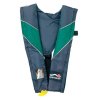Man... Lots of misunderstandings in this thread. Our collective reading comprehension sucks.

Wrong, best glide speed is your indicated speed so wind really has nothing to do with it.
Wind has nothing to do with Vg. It has a LOT to do with where you'll end up. Vg lets you travel farther THROUGH THE AIR. How far you travel across the ground will change with wind, and since we generally have a spot on the ground where we want to end up, wind must be considered.
Glide speed is GROUND SPEED, not Vg. Good luck with that if you don't know the wind.
Careful how you say that... Don't want anyone aiming for Vg on their GPS groundspeed!
For a real world application, the number you want is ground speed, which is available on your gps.
Again, let's not lead any newbies into thinking you want to fly Vg on your GPS. Vg is what's on your airspeed indicator. Convert to true airspeed and compare with what's on your GPS to see if you have a headwind or tailwind component.
You'll go farther in a headwind if you fly faster than Vg, you'll go farther in a tailwind if you fly slower than Vg. Strong tailwind, you want minimum sink speed instead of Vg.
Yes, best glide speed is effected by weight; I think any number quoted in the 'book' will be for full gross. For lesser weights (think no fuel, pilot only) the best glide will be at a lower airspeed. I'll guess that the range from full gross to no fuel/pilot only will be about 10 knots in most SELs (please, someone run the numbers).
For a few of the planes I fly a lot, Vg at full gross vs. Vg with just me and an hour of fuel:
Mooney M20R: 91 / 82
Cessna R182: 80 / 68
DA40: 76 / 66
So yeah, pretty close to 10 knots in each case.
Best glide typically falls somewhere between Vx and Vy (actually I don't understand why Vx doesn't equal min sink and Vy doesn't equal best glide but that's not what the 'books' show).
Think about the power vector and how that might change things...
Here's why I did this:
I am planning a trip that has a 17nm water crossing. At the time I asked, I forgot that it only needed to account for 1/2 the distanc to glide power off.
Yep. What changes with wind speed on an over-water glide is not how far you can go, but where the turn-back point is. If you have the full glide polar for your airplane you may be able to do slightly better in strong winds, but it's best to start out by just calculating the change in your turn-back point based on winds and sink rate.
What happens if the headwind equals your book best glide speed. Where do you end up?
What happens then if you fly ten MPH over your best glide speed?
1. going down right over the spot the engine quit + a little forward movement as the windspeed reduces as altitude is lost
2. You glide less distance.
Not so. Assuming a constant wind as Ron implied, you'd go straight down for #1. But, for #2, while you'd get to the ground faster, you would make more forward progress. You'd be gliding through less air, but you'd be gliding across more land.

 in same post
in same post



